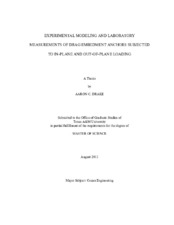| dc.description.abstract | Extreme hurricane events of the past decade are responsible for several drag embedment anchor (DEA) mooring failures of mobile offshore drilling platforms stationed within the Gulf of Mexico. A proposed failure mechanism is caused by out-of-plane loading. The current status of DEA holding capacity is based on empirical design charts and does not include the effects of out-of-plane loading. Experimental modeling using a 1:10 scale generic DEA was performed at the Haynes Coastal Engineering Laboratory at Texas A & M University to examine the effects of out-of-plane load conditions. Instrumentation and specialized devices were constructed to measure the anchor's trajectory through a representative sample of Gulf of Mexico clay with average un-drained shear strength of 0.764 kPa (16 psf). The sediment basin allowed for drag distances of 4.87 m (16 ft) and an embedment depth of 1.37 m (4.5 ft).
The measurements included pitch and roll of the anchor and line tension measured at the shank pad-eye. The variables modeled were fluke angle settings of 22°, 36° and 50°. The initial towline angle was varied from a minimum of 5° to upwards of 20°. Surface out-of-plane angles of 45° and 90° and embedment loading of 15°, 30° and 45° were examined. Curves of the ultimate holding capacity with respect to the out-of-plane towline angle and ultimate embedment depth were developed as functions of out-of-plane loading angles. Analysis of the rate effect indicates that a 46 percent increase in towing velocity causes an average 3 percent increase of holding capacity. The 50° fluke angle embeds an average of 0.7 fluke lengths deeper and has a holding capacity of 0.73 units greater than the 36° setting. The surface out-of-plane tests have a 5.1 percent reduction in holding capacity as the out-of-plane load angle increases from 45° to 90°. For all one fluke length initial towing distance tests, the ultimate holding capacity increases and the ultimate embedment depth decreases as the out-of-plane towing angle increases from 15° to 45°. The three fluke length initial towing distance tests indicate a contrasting trend, in that as the out-of-plane tow angle increases, both the ultimate holding capacity and ultimate embedment depth decrease. | en |


